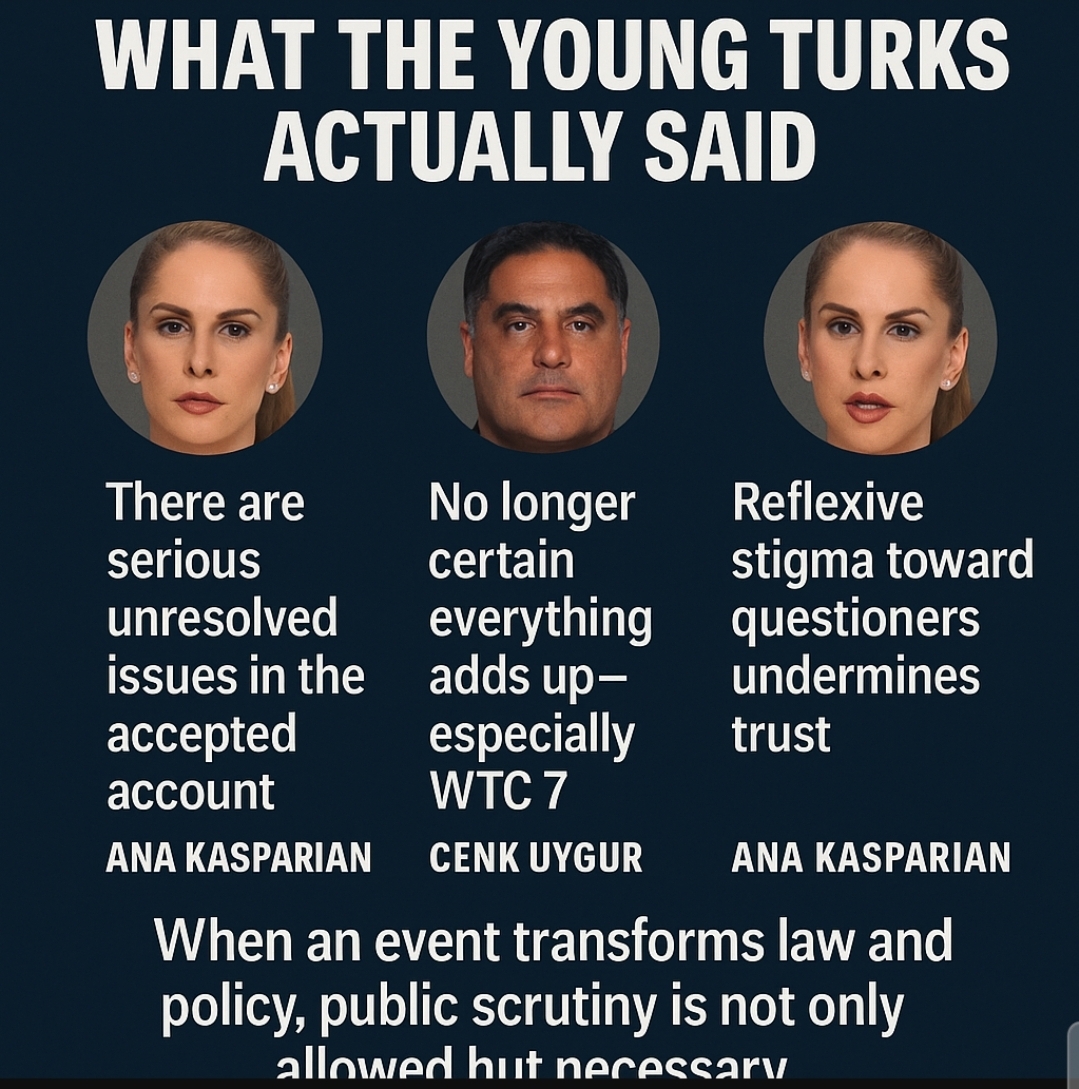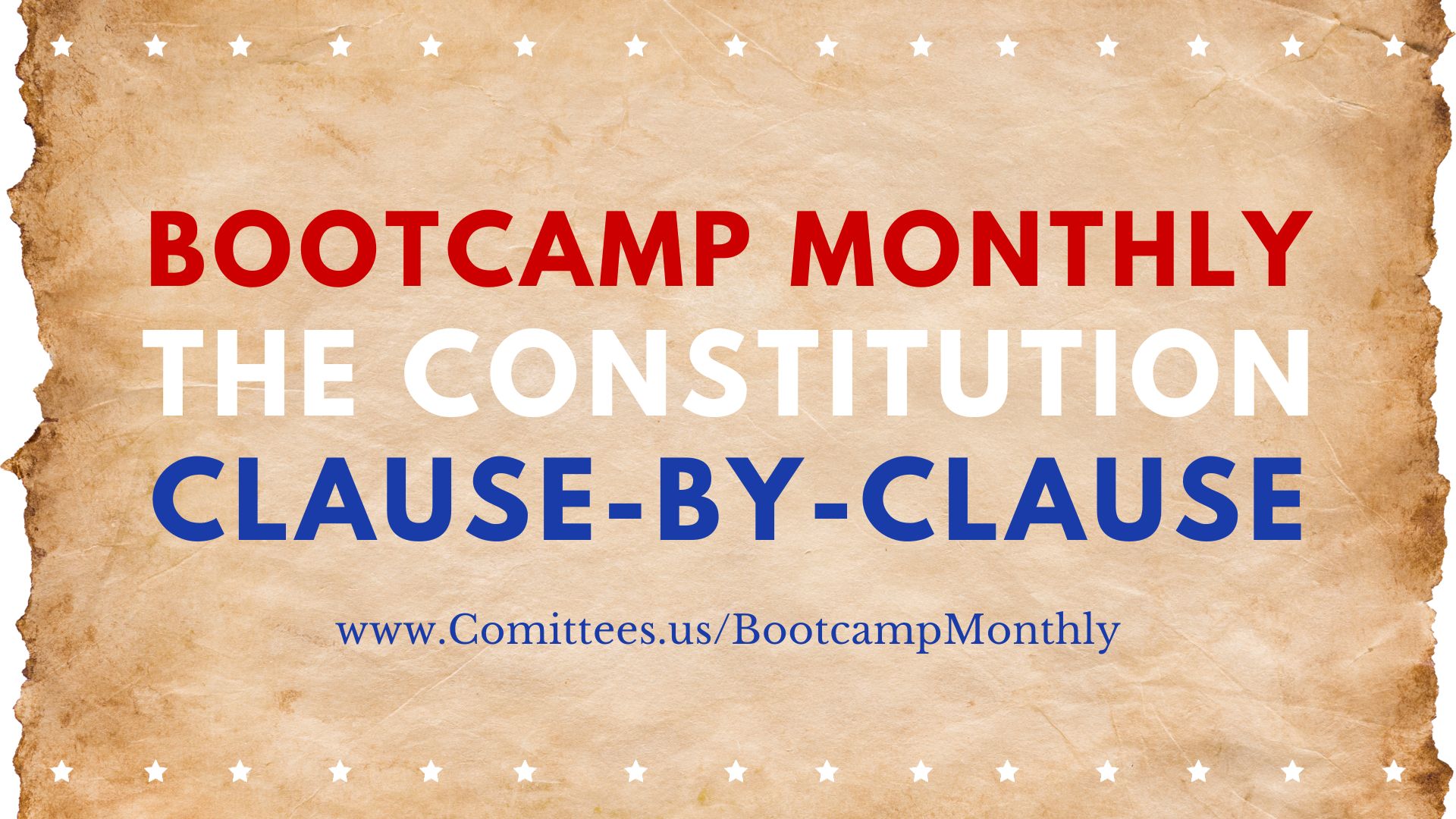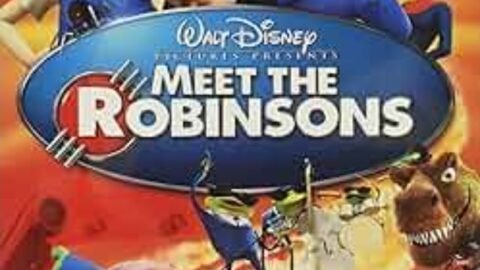This article summarizes the segment from The Young Turks (Cenk Uygur and Ana Kasparian) reacting to Tucker Carlson’s coming 9/11 docuseries and his exchange with Piers Morgan. It reports what the speakers claimed or questioned; it is not an endorsement of any claim.
Chase Hughes has often pointed out that genuine listening is a form of strength, not weakness. When we take the time to hear—even those we oppose—we’re sometimes startled by how much overlap exists at the human level. Everyone wants safety, truth, fairness, and a future they can trust. If we cut through tribal noise, we often find more common ground than we expect.
That’s the lens through which Tucker Carlson’s new 9/11 documentary—and The Young Turks’ response—should be seen. The TYT panel didn’t just dismiss the film out of hand; their nervousness reflected deeper anxieties about narratives, control of history, and the public’s growing skepticism of official stories. The discussion wasn’t just about Tucker—it was about who gets to define “truth” in moments of national trauma.
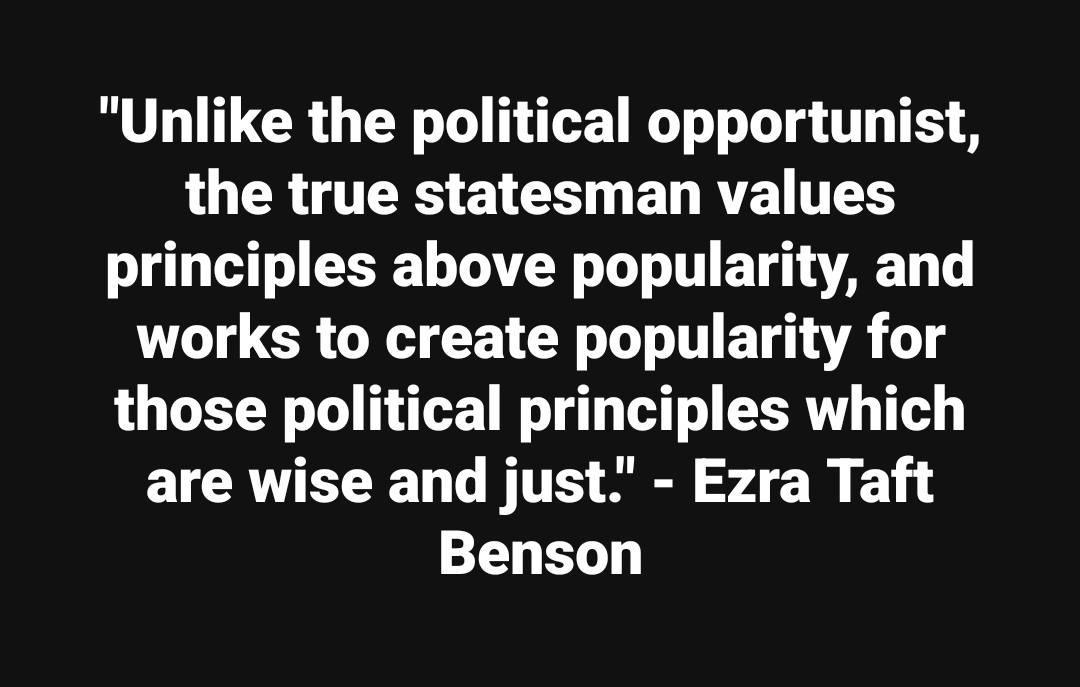
The Setup: A Trailer, An Interview, A Flashpoint
Tucker Carlson’s trailer promises a five-part investigation arguing the official 9/11 story is “a complete lie” and that the 9/11 Commission report amounts to a cover-up. He highlights purported CIA–FBI failures and hints at hidden knowledge and foreign involvement, urging viewers to subscribe and watch all five episodes at once.
The trailer drew enough heat that Piers Morgan brought Carlson on to press him. TYT then devoted a segment to the interview—playing key clips, stressing where they agree on transparency, and where they still have questions.
TYT’s Starting Point: Skeptical, Not Settled
- Cenk Uygur says he once dismissed alternative narratives out of hand. After years of watching government misdeeds and cover-ups in other arenas, he’s no longer certain everything about 9/11 adds up—especially World Trade Center 7 (WTC 7).
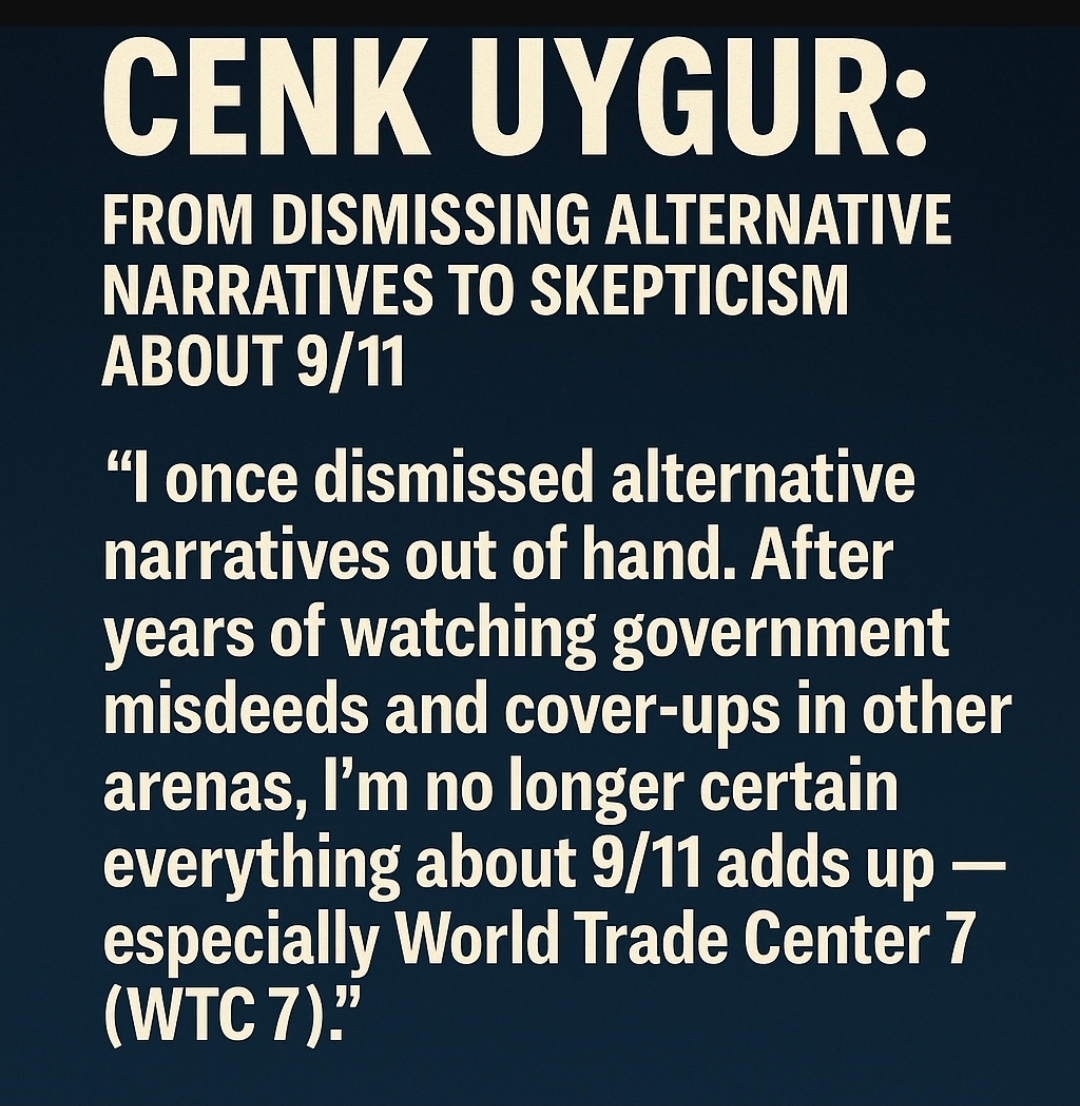
- Ana Kasparian doesn’t claim “inside job,” but says there are serious unresolved issues in the accepted account. She frames TYT’s role as asking legitimate questions, not delivering a grand theory.
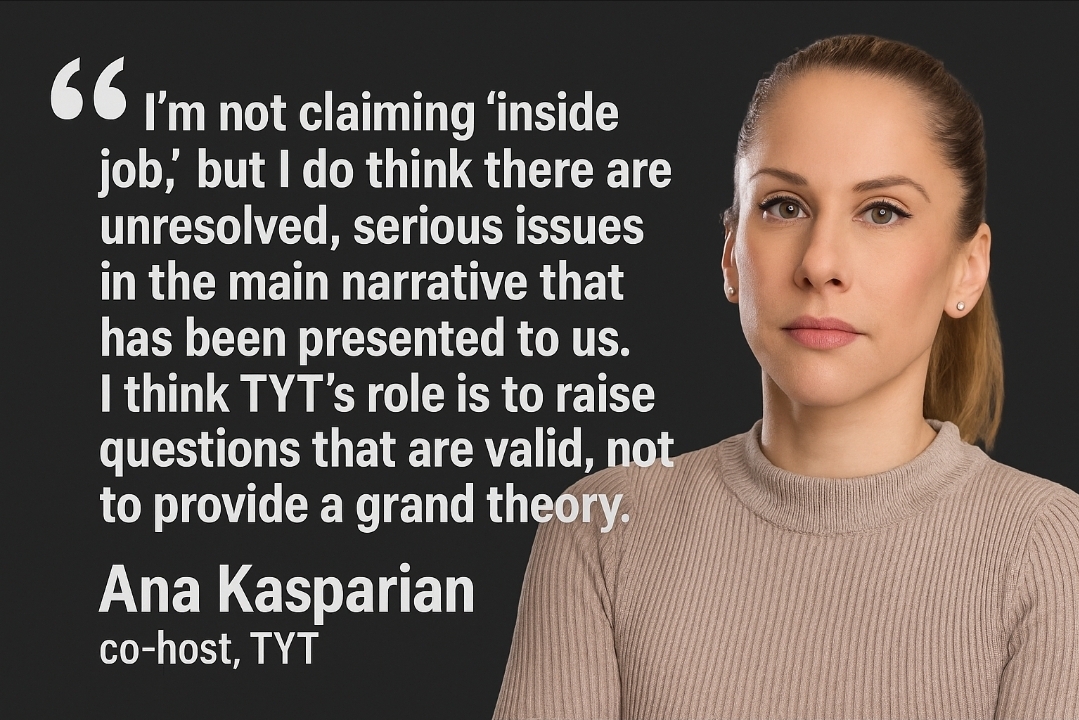
Building 7: The Core Dispute
Carlson’s claim to Piers Morgan: huge parts of the 9/11 story were ignored; WTC 7, which wasn’t struck by a plane and had another building between it and the towers, collapsed later that afternoon. He says there is no plausible explanation in the official narrative and that the Commission “ignored” it.
Morgan’s reply: the official line is that debris and long-burning fires triggered structural failure in a steel-framed building; for years it was a unique case, and he cites a later, allegedly similar collapse abroad to say it’s not singular.
TYT’s reaction:
- Cenk: still hasn’t heard a “proper explanation” for WTC 7 and finds aspects contradictory.
- Ana: if fire explains WTC 7, why didn’t the building in between also fail? She asks what alternate explanation should be investigated if not that one.
Carlson’s additional challenges (as TYT relays them):
- Why was WTC 7 steel carted off quickly and shipped abroad?
- Why do some analyses claim traces of explosive material in dust (his wording);
- Why did some engineers conclude fires alone couldn’t cause that failure;
- Why did the BBC report the building had fallen before it actually did? (Morgan answers that they relied on a bad wire report; Carlson says that still doesn’t explain premature certainty.)
Note: TYT is transmitting Carlson’s questions and their own skepticism. They do not present a new mechanism of collapse; they argue the burden of clarity rests with authorities.
“You Can Ask Now”: The Media-Moment Frame
Cenk’s broader point: we’ve crossed a Rubicon. In the old media environment, airing these doubts could get you labeled a kook and fired. In the digital ecosystem—where big platforms and independent shows thrive—asking is no longer easily punished. TYT casts their segment as permission to question without having to swear allegiance to any conclusion.
Foreknowledge & Markets: The Short-Selling Story
Carlson’s claim: someone shorted airline stocks and certain banks just before 9/11 and profited; he says the FBI knows who but hasn’t publicly disclosed the identity. He argues the public deserves to know who made those trades and why.
TYT’s view: could be coincidence depending on who did it and the scale—but the question is legitimate. The reflex to shout “conspiracy theorist” at anyone who asks is, to them, a red flag.
Flights & Detainees: The Bin Ladens and “Five Israelis”
- Bin Laden family flights: TYT revives the long-standing question: why were some Bin Laden relatives flown out soon after the attacks? They argue that asking for a clear rationale is reasonable.
- The “five Israelis” episode (as TYT recounts it):
Ana cites a witness who saw five men taking photos and “celebrating,” their detention for more than two months, an FBI belief that at least two had intelligence ties, and an order from then–Attorney General John Ashcroft to release and send them back. She mentions a moving company described as a front and cash/passports found in a truck.
Cenk’s emphasis: why were they released? He insists that asking that question is not bigotry—it’s scrutiny.
TYT explicitly does not claim these facts prove authorship or coordination of the attacks by any foreign government. Their point is: if there are legitimate answers, provide them.
Why Questions Matter: Policy Consequences
Ana reminds viewers that 9/11 reordered American life: Patriot Act, mass surveillance, foreign wars, and trillions in costs. TYT argues that when an event transforms law and policy on that scale, public scrutiny is not only allowed but necessary—and reflexive stigma toward questioners undermines trust.
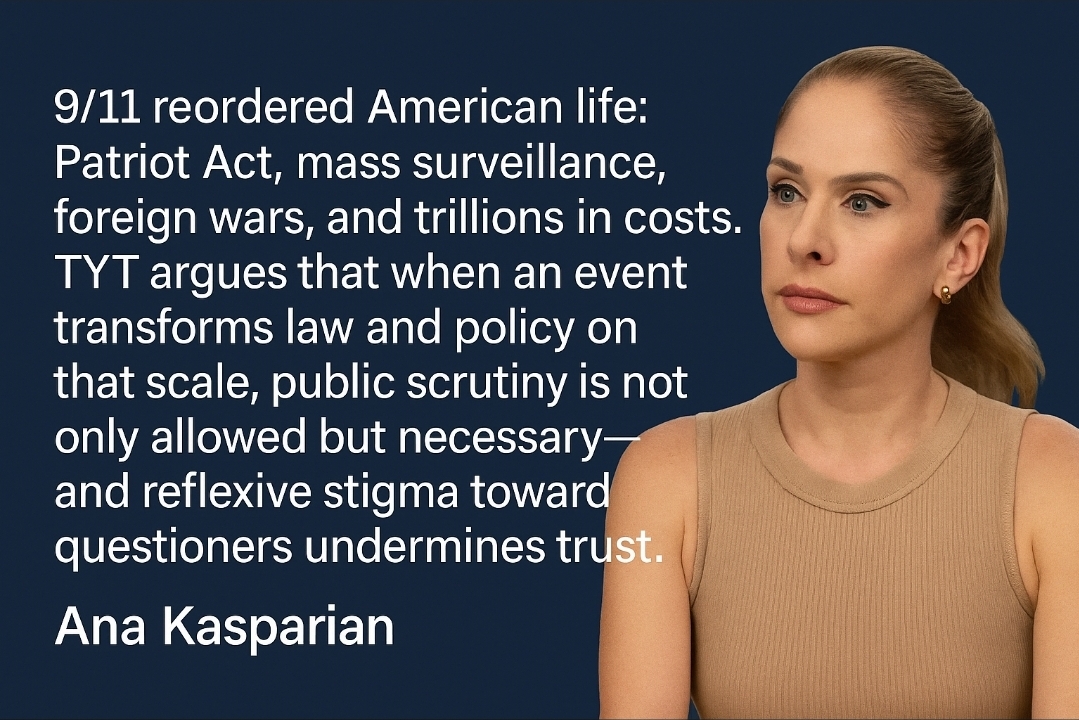
Bottom Line from the TYT Segment
- TYT is not offering a grand alternative theory.
- They argue there are gaps and contradictions—chiefly around WTC 7, alleged foreknowledge trades, and the handling of specific detainees and flights—that deserve transparent answers rather than reputational punishment for asking.
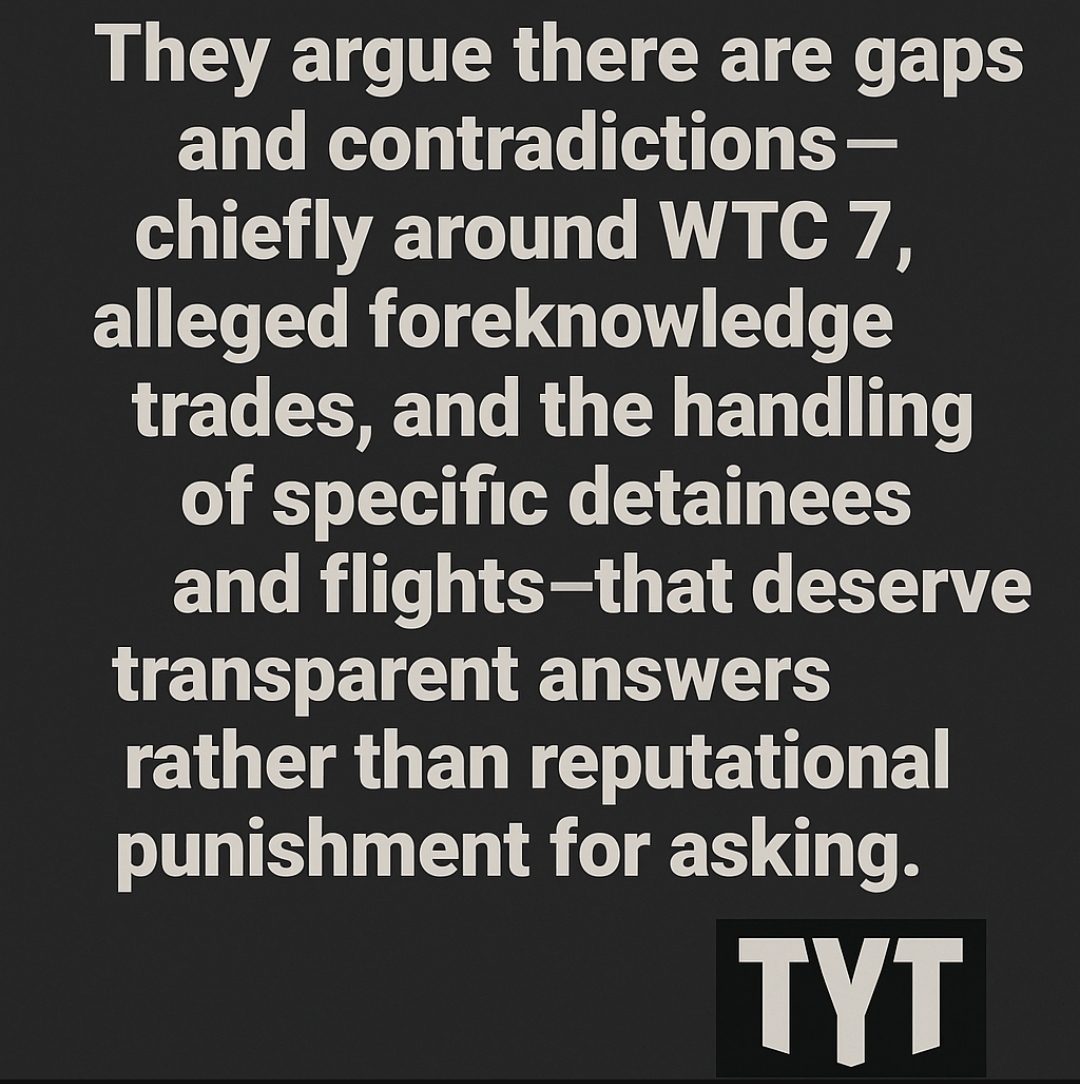
- Carlson’s series promises to advance those questions; Morgan articulates the standard explanation. TYT positions itself as the forum insisting that asking ≠ concluding, and that accountability requires daylight.
If you’re digging deeper, TYT’s advice—implicit throughout the segment—is to separate three lanes: what Carlson is alleging, what official reports concluded, and what independent experts have said, and then judge each claim on its evidence rather than on the social cost of asking it.
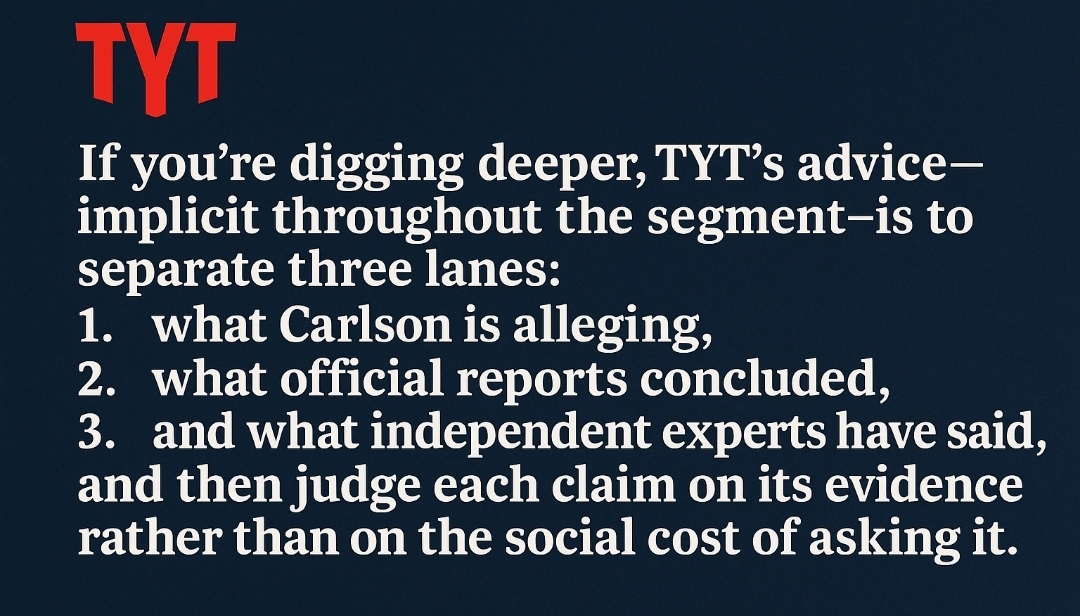
After the Clip: What The Rubin Report Confrontation With Cenk Uygur Reveals About Blame, Rhetoric, and Responsibility
Based on the provided transcript of a segment featuring Dave Rubin, Cenk Uygur, and Piers Morgan.
Lead
In a charged exchange following the killing of Charlie Kirk, Dave Rubin used The Rubin Report to press Cenk Uygur over past headlines and a resurfaced clip about “easy martyrdom.” Uygur condemned the murder, accused Rubin of ripping context, and insisted he’s never called Donald Trump a Nazi. Piers Morgan tried to keep the discussion anchored to a basic, endangered norm: debate without violence.
What follows is an article-length narrative and analysis of the segment—what each participant argued, what evidence they produced, and what the clash says about our media ecosystem in moments of crisis.
The Setup: From Condolence to Confrontation
All three voices begin from horror: a high-profile political figure has been murdered. Rubin adds a broader personal arc—he says he once “happily” identified as liberal but became alienated from a punitive “woke left.” He points to celebratory reaction clips on TikTok as evidence that a culture of dehumanization has metastasized from cancellation to lethal violence.
Then comes the pivot. Rubin argues that the caricature of Charlie Kirk—a bigot and misogynist—was constructed by influential outlets, and he turns directly to Cenk Uygur to ask whether TYT stands by a series of hostile video titles about Kirk. Uygur, bristling, says Rubin is dressing up a “reconciliation” segment to rile people against him with misleading frame jobs.
Piers Morgan repeatedly interjects to re-center the human loss and the democratic baseline: ideas should be contested; people should not be killed for them.
Rubin’s Case: “The Hysteria Isn’t Symmetrical”
Rubin structures his indictment around two planks:
- Misrepresentation of Kirk’s character. He reads out ten TYT/TYT-adjacent video titles (e.g., “Charlie Kirk gives piggish advice to high school girls,” “Charlie Kirk boasts about his all-white basketball team”) and says they’re part of a pattern that paints Kirk as racist and misogynist. He counters that Kirk had “not a bone of racism or misogyny” and was, in Rubin’s experience, decent and open to debate.
- A culture that primes violence. Rubin says perpetual, maximalist coverage—especially the “Trump/Nazi” framing—has jinned up “otherwise good people” toward extremism. He stresses only the shooter bears direct blame, but he rejects the idea that incitement is evenly distributed across left and right. Before “reconciliation,” he argues, there should be contrition—like deleting overheated titles.
To drive the point home, Rubin plays an older clip of Uygur talking about an Antifa confrontation at a Kirk breakfast, saying moments like that “allow for easy martyrdom” and characterizing Kirk as smiling at the prospect of claiming victimhood. Rubin uses it to suggest Uygur has long fed a narrative that trivializes the risks people like Kirk faced.
Uygur’s Counter: “You’re Stripping Context to Smear Me”
Uygur responds on three fronts:
- On violence: He condemns the murder unequivocally and rejects any celebration. He frames himself as consistently pro-speech, anti-violence, and says the entire exchange should start from empathy for a young family that just lost a husband and father.
- On the “martyrdom” clip: He calls Rubin’s use “totally out of context,” saying the comment referred to rhetorical victimhood in a scuffle at a breakfast—not to physical harm or a wish for it. He accuses Rubin of using old material in bad faith “to get people angry” at him.
- On “Trump/Nazi” coverage: Uygur says he has not labeled Trump a Nazi. He claims most of those titles concern neo-Nazi reactions to Trump, not TYT declaring Trump a Nazi. On Charlottesville, Uygur reasserts that Trump said “very fine people on both sides,” and even if Trump later condemned white supremacists in the same presser, praising “both sides” still swept in people championing the Confederacy—unacceptable in his view.
Uygur’s through-line is that Rubin is pretending at reconciliation while escalating, in a way Uygur says is dangerous in a raw moment.
Piers Morgan’s Role: Pulling Back to First Principles
Morgan tries to hold the line on two points:
- Human loss first. He asks both sides to recognize the “massive” human cost—the death of a 31-year-old husband and father—and to reaffirm that a democratic society depends on argument, not assassination.
- Norms under strain. He signals the broader peril: if high-visibility figures can be killed for their beliefs, more people will self-censor, and the civic space for disagreement will shrink.
The Flashpoint Within the Flashpoint: “Very Fine People”
The segment briefly re-litigates Charlottesville. Rubin underscores that Trump, in the same exchange, said white supremacists should be “condemned completely,” calling the enduring “very fine people” narrative a debunked hoax. Uygur concedes that condemnation line exists but maintains the “both sides” formulation still functionally valorized a crowd that included defenders of a white-supremacist legacy. The disagreement is less about words on a transcript than about which sentence a culture should weight more heavily—and what that weighting signals to extremists.
What the Segment Shows About Media Incentives
Even as Rubin calls for contrition and Uygur calls out selective editing, both lean on the lingua franca of modern conflict: receipts—clip fragments and video titles—used as proofs of character. That tactic is now table stakes across the spectrum. In a normal news cycle, it’s a way to score points. In a crisis, it’s combustible.
The conversation demonstrates how quickly a shared condemnation of violence can fracture into meta-arguments about who radicalized whom, and how easily “context” becomes the most contested resource in the room.
Three Takeaways
- Everyone condemned the murder. That’s not trivial. In a feverish environment, clear, early, cross-partisan condemnation is a civic good.
- Accountability vs. escalation is the unresolved tension. Rubin argues the left must own its rhetorical excesses; Uygur says Rubin is selectively weaponizing context and inflaming things further. Both are, in effect, arguing about how to lower the temperature while disputing who must lower it first.
- The norm that needs defending is simple: ideas vs. violence. Morgan’s interjections keep pointing back to that basic social contract. Once people believe violence “works” better than argument, speech chills, security hardens, and the public sphere shrinks.
A Better Next Segment (If Anyone Asked)
- Start with the family and the fact pattern. Name the victim’s humanity; then stick to confirmed facts before causation claims.
- Debate one thing at a time. If the question is “Do these ten headlines fairly represent Kirk’s views?”, answer that on the merits—with full clips, not chyrons.
- Commit to future framing rules. If a guest misstates, correct in-segment; if a title overreaches, amend it and annotate the change. That’s how you show contrition without self-erasure.
- Model disagreement. Bring on two people who disagree and require each to steelman the other’s core point before rebutting. It slows the blood sport and raises the bar.
Bottom Line
The segment captures a countrywide dilemma in miniature: how to apportion rhetorical responsibility without turning grief into another brick in the outrage economy. Rubin wants contrition from media voices he says helped paint a target on Charlie Kirk; Uygur says he’s being smeared with out-of-context receipts while he’s urging empathy and non-violence. Morgan keeps pointing to the only durable rule a plural democracy has: we argue—we do not kill.
If we can’t agree on that, the rest is just kindling.
“Watch Cenk Listen in Horror”: What Happened on The Rubin Report When Dave Rubin Played the Clip — Point-by-Point
Context note: The following is a neutral, point-by-point breakdown of the conversation as it appears in the provided transcript featuring Dave Rubin, Cenk Uygur, and Piers (Morgan). It recounts what each person said or claimed in the segment.
1) Dave Rubin’s opening frame
- Rubin’s personal pivot: Says he once “happily” identified as a liberal but became alienated from the “woke left,” which he describes as denying science/biology and embracing a punitive cancel culture.
- From cancellation to killing: Argues the culture has progressed from shaming and professional destruction to “murdered in cold blood” for opinions—referring to the killing of Charlie Kirk.
- Reaction videos as evidence: Points to TikTok clips of people “joyously celebrating” the murder, calling the atmosphere “unnerving” and “scary.”
2) “It’s not even his opinions”: Rubin’s claim about misrepresentation
- Misattribution charge: Rubin says the outrage wasn’t about Kirk’s true beliefs but about beliefs the left’s “thought leaders” falsely ascribed to him.
- Reconciliation… with receipts: Rubin says he’s in a reconciliatory mood, then turns to Cenk Uygur (whom he calls “Jenk”), producing 10 headlines from TYT about Kirk and asks if Uygur stands by them:
- “Charlie Kirk says prominent Black women took white people’s spots”
- “Charlie Kirk boasts about his all-white basketball team”
- “Charlie Kirk gives piggish advice to high school girls”
- “Ex-employee exposes Charlie Kirk’s grift”
- “Charlie Kirk embarrasses himself”
- “Charlie Kirk’s brain melts explaining anti-vax conspiracy”
- “Charlie Kirk rants about women in their 30s”
- “Charlie Kirk has literally no clue how the real world works”
- “Charlie Kirk gets triggered. Declines appearance over pronouns”
- “Charlie Kirk doubles down on women-hating backlash”
- Character defense: Rubin says Kirk had no racism or misogyny in him; calls detractors “liars” who gin up “otherwise good people.”
- Shooter narrative: Says early info suggested the shooter had a stable life (“going to college”), and promises we’ll “find out where he got radicalized.”
- Asymmetry claim: Urges people not to pretend “this thing is going both ways,” implying political incitement is not symmetrical.
3) The “martyr” confrontation
- Rubin’s challenge: Asks Uygur, “Do you think Charlie wanted to be martyred? Yes or no?”
- Uygur’s answer: “Of course not. What kind of question is that?”
- Rubin’s audio clip: Plays an old video of Uygur referencing Kirk at a breakfast event (Rubin says Antifa accosted Kirk there). In the clip, Uygur says situations like that “allow for easy martyrdom” for “these guys,” and describes Kirk as smiling, thinking, “Yes, I’m now the victim.”
- Uygur’s pushback: Calls it “totally out of context,” says he doesn’t even know what Rubin is talking about initially, then insists the comment was about rhetoric/words at that event, not about wanting to be killed. He becomes heated (“listen, brother… loser… Jesus Christ”), accusing Rubin of bad faith.
4) Piers tries to moderate
- Piers’s reset: Notes “a massive loss on a human level” and praises Kirk’s commitment to debate. Emphasizes what a democratic society should be: ideas contested without violence.
5) Rubin’s personal note and the Trump/Nazi headlines
- Personal relationship: Rubin shares he’s gay, married, and that he and his husband spoke amicably with Kirk and his wife about differences—including marriage—framing Kirk as civil and open to debate.
- Pivot to Trump coverage: Rubin argues a broader media climate of hysteria on the left, reading TYT/TYT-adjacent video titles about Trump and Nazis:
- “Trump cuts anti-Nazi program,” “Trump spreading Nazi propaganda,” “Nazis encouraged by Trump’s Charlottesville response,” “Trump defends Nazis (very fine people),” “Trump retweets a neo-Nazi again,” etc.
- Rubin’s point: Says the “endless hysteria” primes people to do “crazy things.” Reiterates:
- Only the murderer is directly responsible, but pretending the climate is symmetrical is “deeply dangerous.”
- He calls for contrition before reconciliation—e.g., deleting inflammatory titles.
6) Uygur’s counter: “You’re misleading and inciting”
- Anger at frame: Uygur says Rubin is pretending reconciliation while stoking anger at him with misleading claims, “trying to get people to do violence” against him.
- On the titles: Says “80% of those titles” weren’t him calling Trump a Nazi but about neo-Nazi reactions to Trump.
- Charlottesville fight: Uygur insists Trump did say “very fine people on both sides.” Rubin replies that in the next sentence Trump condemned white supremacists—calling the “very fine people” line the “biggest hoax” narrative.
- Uygur’s nuance: Says even if Trump meant non-Nazi statue supporters, he rejects praising people “in favor of the Confederacy” and a legacy of lynching—so he still finds the “both sides” framing unacceptable.
7) Tone, tactics, and stakes
- Rubin’s strategy: Contrasts reconciliation language with concrete receipts (headlines, clip, Trump-Nazi titles) to press Uygur for accountability and to argue the left’s rhetoric fuels radicalization.
- Uygur’s stance: Denounces violence unequivocally, rejects being cast as an inciter, and argues Rubin is weaponizing out-of-context material to smear him and the left.
- Piers’s role: Attempts to keep the exchange grounded in the human tragedy and in the democratic norm of argument over violence.
8) Core claims laid side-by-side
- Rubin:
- The post-liberal left misrepresents opponents, inflames hatred, and asymmetrically normalizes violent outcomes.
- TYT headlines and Uygur’s past words about “martyrdom” feed a hostile climate.
- The killer alone is culpable, but cultural blame is not evenly distributed.
- Uygur:
- He never called Trump a Nazi; many titles reflect neo-Nazi reactions to Trump, not TYT asserting “Trump is a Nazi.”
- The “martyrdom” clip is old and context-specific (words at a breakfast fracas), not a wish for real-world harm.
- Rubin’s approach is misleading, escalatory, and risks further violence.
9) What the segment reveals (from the transcript itself)
- Competing narratives about responsibility: Both sides condemn the killing; they diverge on whether the broader media climate is symmetrical and who needs to show contrition.
- Weaponized context: Audio snippets and video titles become ammunition—Rubin to argue escalation by the left; Uygur to argue misrepresentation.
- Norm at stake: Piers and Rubin explicitly affirm debate > violence; Uygur does too, while warning against smear-driven escalation.
TL;DR of the exchange
- Dave Rubin says the left’s misrepresentations and hysteria helped create a culture where opponents get dehumanized—and he plays an old clip of Cenk Uygur talking about “easy martyrdom” to prove a pattern.
- Cenk Uygur says the clip is out of context, rejects any suggestion he wanted harm, insists TYT didn’t call Trump a Nazi, and accuses Rubin of stoking anger against him.
- Piers Morgan tries to center the conversation on the human loss and the need to protect a democratic culture of argument without violence.
That’s what’s on the tape, point-by-point.

